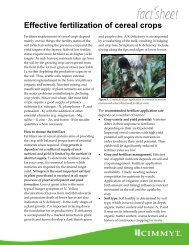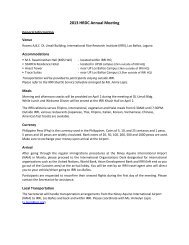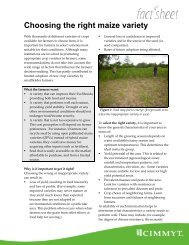Field instrumentation - Rice Knowledge Bank - International Rice ...
Field instrumentation - Rice Knowledge Bank - International Rice ...
Field instrumentation - Rice Knowledge Bank - International Rice ...
Create successful ePaper yourself
Turn your PDF publications into a flip-book with our unique Google optimized e-Paper software.
<strong>Field</strong> <strong>instrumentation</strong><br />
Crop and Environmental Sciences Division<br />
<strong>International</strong> <strong>Rice</strong> Research Institute<br />
Los Baños, Philippines
<strong>Field</strong> water balance lowland rice
Two types of instruments<br />
Instruments to measure water inflows and<br />
outflows<br />
Instruments to characterize field water<br />
status and groundwater (“hidden water<br />
source”)
Two simple tools to characterize<br />
water environment and aid in field<br />
water management<br />
• <strong>Field</strong> water tube<br />
• Groundwater tube
<strong>Field</strong> water tube
With standing water<br />
on top of the surface:<br />
read this<br />
20 cm diameter PVC pipe<br />
Use a ruler to<br />
Measure water depth<br />
0<br />
15 cm<br />
Soil surface<br />
Puddled<br />
topsoil<br />
20 cm<br />
With water below<br />
the soil surface:<br />
read this<br />
Plow pan<br />
Holes are 5 mm in diameter,<br />
and spaced 2 cm apart
<strong>Field</strong> water tube - installation<br />
Push tube by<br />
hand vertically<br />
Drive cylinder<br />
using mallet<br />
Check clearance<br />
from soil surface<br />
Appearance of<br />
installed PW tube<br />
Remove soil<br />
inside the tube<br />
Check and level the<br />
Top of the tube
<strong>Field</strong> water tube – measurement<br />
Water depth = H – D<br />
D = depth of field water<br />
table<br />
H = height from soil<br />
surface to the top of<br />
the tube
A practical indicator for water in field
date<br />
<strong>Field</strong> water depths<br />
150<br />
100<br />
50<br />
0<br />
-50<br />
-100<br />
-150<br />
-200<br />
Continuously<br />
flooded<br />
-250<br />
Tuanlin 1999<br />
150<br />
100<br />
50<br />
Water depth [mm]<br />
0<br />
-50<br />
-100<br />
-150<br />
-200<br />
-250<br />
150<br />
100<br />
Tuanlin 2000<br />
Controlled<br />
Irrigation<br />
50<br />
0<br />
-50<br />
-100<br />
-150<br />
-200<br />
-250<br />
Phil<strong>Rice</strong> 2001<br />
date
‣ Made of 5-cm diameter<br />
PVC pipe, 175-200 cm long,<br />
with perforations (0.5 cm<br />
diameter) in the bottom 50<br />
cm.<br />
Groundwater tube<br />
‣ Installed into a bund using<br />
an auger (soil dril) of the<br />
same diameter to the<br />
required depth<br />
‣ Should stick out about 50<br />
cm above bund surface<br />
‣ Use stick to measure water<br />
depth
Cover<br />
(used tin can)<br />
5 cm diameter PVC<br />
pipe<br />
Bund surface<br />
50 cm<br />
Read<br />
here<br />
Groundwater level<br />
100 cm<br />
200 cm<br />
Measuring<br />
device<br />
Holes are 5 mm<br />
in diameter; 2 cm apart<br />
50 cm
Groundwater measurements<br />
20<br />
0<br />
-20<br />
-40<br />
-60<br />
-80<br />
-100<br />
Groundwater depth (cm)<br />
18 38 58 78 98 118<br />
Day number<br />
Tuanlin, China, 2002<br />
20<br />
Groundwater depth (cm)<br />
( 20)<br />
0<br />
168 193 218 243 268 293<br />
-20<br />
-40<br />
-60<br />
-80<br />
-100<br />
Groundwater depth (cm)<br />
Panicle<br />
initiation<br />
Flow ering<br />
Changle, China, 2002<br />
Day number<br />
Harvest<br />
-20<br />
-60<br />
-100<br />
-140<br />
-180<br />
-220<br />
-260<br />
-300<br />
37270<br />
37277<br />
37284<br />
37291<br />
37298<br />
37305<br />
37312<br />
37319<br />
37326<br />
37333<br />
37340<br />
37347<br />
37354<br />
37361<br />
37368<br />
37375<br />
Dolores, Philipines, 2002
Soil water tension meter
Soil water tension in an aerobic soil<br />
100<br />
Soil moisture tension (kPa)<br />
90<br />
80<br />
70<br />
60<br />
50<br />
40<br />
30<br />
20<br />
10<br />
0<br />
Panicle<br />
initiation Flowering Harvest<br />
175 200 225 250 275 300<br />
Day number
Instruments to measure water flows<br />
Rain + irrigation = evaporation + transpiration<br />
+ percolation + seepage<br />
+ overbund flow + d(storage)<br />
Specialized equipment:<br />
• Inflows: rain gauge, flow meters<br />
• Outflows: evaporation pan, percolation<br />
ring, seepage (), surface water in<br />
channels<br />
Weather station to calculate evaporation<br />
and transpiration
Rainfall rain gauge<br />
The catchment<br />
funnel<br />
The measuring tube<br />
The fixing bracket<br />
The overflow tube<br />
‣ Raingauge<br />
‣ collector area<br />
150 to 200 cm 2<br />
‣ 30 cm to 1 m above the ground
Irrigation<br />
Flow meter in<br />
pressure pipes
Irrigation<br />
Box weir for surface<br />
water
Irrigation/drainage<br />
Simple weir for<br />
surface water
Irrigation/drainage<br />
Flume for surface<br />
water
Evaporation pan<br />
‣ Keep away from other instruments (2x ht)<br />
‣ Level the pan<br />
‣ Install the stilling well and the fixed point<br />
‣ Add water until the water reaches the tip of the fixed point and can<br />
be seen as a small dot
Evaporation rings<br />
Soil evaporation
Percolation ring<br />
‣ 20 cm in diameter<br />
cylinder - open on<br />
both ends<br />
‣ Covered – to avoid<br />
evaporation and<br />
rainfall
Percolation meter - installation<br />
Push cylinder by<br />
hand vertically<br />
Drive cylinder<br />
using mallet<br />
Check clearance<br />
from soil surface<br />
Check and<br />
level<br />
percolation<br />
tube
Percolation meter - measurement<br />
Put a mark on the<br />
wall of the<br />
cylinder.<br />
Always measure<br />
at this point<br />
Set water levels<br />
inside = outside.<br />
Reset water level<br />
if not. Take<br />
readings after<br />
reset<br />
Take readings d i<br />
and d f from water<br />
surface to the top<br />
of tube. Compute<br />
P = d i -d f<br />
After each<br />
reading, cover<br />
the cylinder to<br />
prevent other<br />
losses (rain,<br />
evaporation)
Large percolation<br />
ring in field
Rain + irrigation = evaporation + transpiration<br />
+ percolation + seepage<br />
+ overbund flow + d(storage)<br />
As surface flow in drain<br />
As “rest term” of balance
Weather station (o.a., calculate ET)<br />
Temperature<br />
Humidity<br />
Evaporation pan<br />
Rain gauge<br />
Sunshine meter<br />
Radiometer<br />
Wind speed (missing)





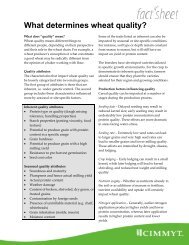


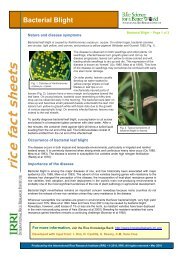

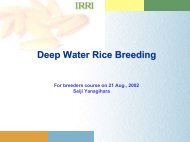
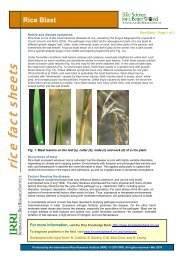
![International Standards' Organization â Rice Specification [ISO 7301]](https://img.yumpu.com/36696862/1/190x245/international-standards-organization-a-rice-specification-iso-7301.jpg?quality=85)

